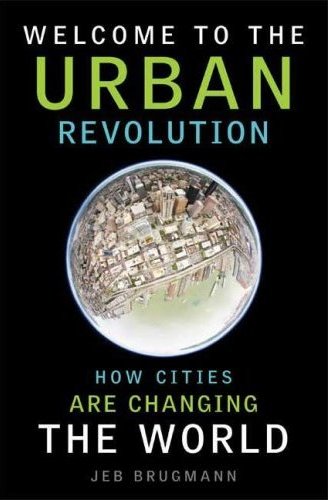
Welcome to the Urban Revolution: How Cities are Changing the World
by Jeb Brugmann
–Reviewed by Jodie Liu
If it’s difficult to imagine the French Revolution without Paris, or the American Revolution without Boston, then it’s easy to see how the term “revolution” can be applied to the urbanization phenomenon.
But Jeb Brugmann’s interest in cities doesn’t lie in how they give rise to ideological upheavals. In Welcome to the Urban Revolution: How Cities Are Changing the World, Brugmann describes the rich character of urban life and analyzes the social implications of growth to form unique, authentic portraits of different developing cities. He ultimately shows what urbanization means for the growing number of city-dwellers, as well as for everyone else who is about to enter, willingly or otherwise, the world of high rises and high efficiency.
Brugmann holds cities up to a magnifying lens: urbanization may be a global-scale phenomenon, but Brugmann finds that the movement’s magnitude is best observed with a highly localized viewpoint. Brugmann’s findings draw from personal fieldwork in Dharavi, India; Machala, Ecuador; and Curitaba, Brazil, to name a few. Such cities have yet to register as the movers and shakers of urbanization, but Brugmann contests they demonstrate the true successes and challenges of the urbanization movement.
Dharavi, for instance, wields a notorious reputation as a squalid, destitute slum – a black sheep in the center of Mumbai’s more modernized neighborhoods. Yet, Brugmann shows that Dharavi’s inhabitants have actually used their maligned heavy population density “to create their own Industrial Revolution.” In wealthier neighborhoods, homes are “empty during the day and businesses are empty at night,” but in Dharavi, all buildings are “in constant use,” maximizing efficiency and accelerating economic growth. Though the living conditions in Dharavi have much to improve upon, Brugmann shows that Dharavi is not without its triumphs.
And a well-established city is not without its challenges. Strolling through Barcelona’s old Gracia District, Brugmann identifies a uniquely Barcelonan way of employing espai public, or public space, to meld private lives with city culture. Here, espai public “is not a public zone separate from the private city; it is a… territory of streets and squares where private interests and public uses are vitally interwoven.” But while the Gracia’s District’s tradition of “cultural homogeneity, regional commerce, and political isolation” makes for easy interconnectedness within the city, Brugmann notes that such homogeneity won’t help Barcelona to thrive in a diverse global market.
Through all the diverse portraits of cities, Brugmann manages to find a sense of unity in his pitch for sustainable development through city building. Brugmann claims that, with the rapid rate of urbanization, the most orderly way for cities to thrive sustainably is to develop into what he calls citysystems-“unique, spatially compact and complete” entities that can operate in a more or less self-sufficient manner. The key to making such systems – Brugmann cites Dharavi as a example – is to allow them to “grow organically” as the “product of trial-and-error” rather than scientific planning.
Clearly, Brugmann is most concerned with urban individualism. Each city has distinct values and ways of social interaction, and in order to bring today’s cities into the future, Brugmann argues for acknowledging and cultivating the unique qualities of each city. Dharavi is not Barcelona is not Moscow, Brugmann explains, and urban growth in each of these cities must begin literally from the ground up.
Excerpt: “When we first started developing city-to-city partnerships in the Soviet Union in 1985, local opposition to the system there was observable everywhere: in living rooms, cafes, workplaces, universities, and churches. There was a new boldness in the expression of resistance, even in small ways. On arrival in Moscow I would regularly visit a once-prominent musician who had been professionally marginalized for her views. She would use the occasion of these visits to flagrantly demonstrate her independence. Whereas we held our first meeting in the presumed privacy of her apartment on Moscow’s periphery, she developed the confidence during these years to flout her contact with foreigners right in the lobby of the downtown-KGB-riddled Intourist hotel. Once inside she’d unveil a basket of rare meats for us to eat under their noses. This was a costly picnic for her. Meat was in short supply. But it was a way of saying, ‘You cannot stop me from having a good life.'”
Further Reading: The New Global Frontier: Urbanization, Poverty and Environment in the 21st Century and Sustainable Urbanism: Urban Design With Nature




Send A Letter To the Editors